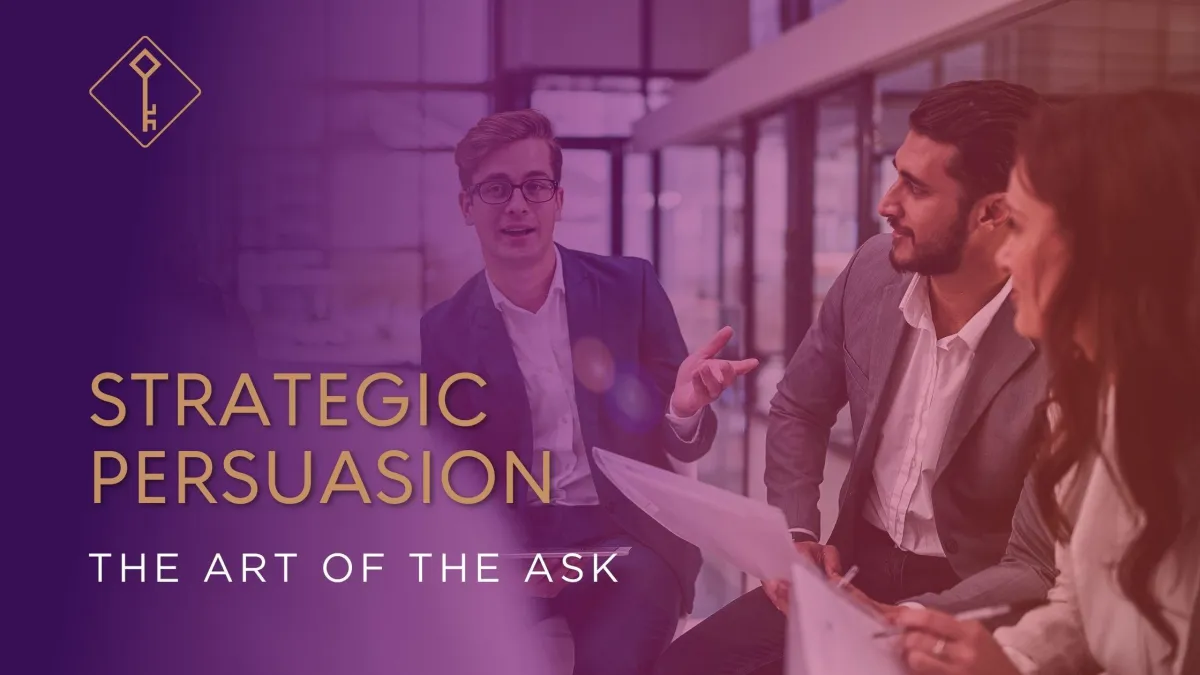
Strategic Persuasion: The Art of the Ask
Summary:
Most leaders approach persuasion like a performance. But real persuasion is less about what you say—and more about how you show up. In this article, we’ll explore a modern approach to persuasion rooted in presence, emotional clarity, and conversation structure that leads with trust.
Strategic Persuasion: How to Guide Conversations with Trust
Most people think persuasion is about what you say.
But the best persuaders know—it’s about what others feel when you say it.
Strategic Persuasion Isn’t About Performance—It’s About Presence
If you’ve ever left a conversation thinking, “I said everything right. So why didn’t it land?”—you’re not alone.
That’s the trap of performance-based persuasion.
You script, you prepare, you deliver with polish… but still, the message misses.
Why?
Because persuasion doesn’t work unless people feel safe.
No amount of precision matters if the energy behind it feels pressured, rushed, or rehearsed.
Strategic persuasion is something different.
It’s about leading a conversation with emotional intelligence and calm confidence—so your message creates connection, not resistance.
Why Logic Alone Doesn’t Work
Most people try to persuade in reverse.
They lead with logic. Numbers. Credentials. Rational arguments.
But neuroscience tells us:
95% of decisions happen subconsciously.
People make emotional decisions—and then justify them with logic.
So when you need to persuade, your message must start with emotional clarity.
This doesn’t mean you become overly emotional.
It means you tune into what matters most to the other person:
What they care about
What they’re afraid of
What they stand to gain or lose
Then, once they feel seen, your logic can land.
Only then does your credibility actually stick.
The ELC Framework: Emotion → Logic → Credibility
A modern approach to persuasive leadership follows this order:
Emotion – Start with understanding. Show you get their context and concerns.
Logic – Offer data, structure, or reasoning that supports what they care about.
Credibility – Let your track record and clarity reinforce the trust you’ve built.
If you reverse that order, persuasion often fails.
Because authority without empathy feels cold.
And logic without emotional safety? Gets filtered as noise.
Ask Without Over-Attaching
Another common block to persuasion: attachment to the outcome.
When we tie our worth to whether the other person says yes, our energy changes.
We rush.
We defend.
We oversell.
But when we ask from a place of clarity and centeredness, the ask becomes an invitation—not a pressure tactic.
One powerful approach is the A.L.I.G.N. Method—a five-step flow I teach to help leaders guide high-stakes conversations without losing their grounding:
Acknowledge – Their current reality or concern
Lead – With intention, not assumption
Inform – Share your perspective or offer
Ground – Reaffirm your why or values
Navigate – Open space for shared direction
It’s less script, more compass.
And it helps you avoid the most common persuasion pitfall: bulldozing.
What Makes People Say Yes?
According to behavioral psychologist Robert Cialdini, people say yes when six key elements are present:
Reciprocity – They’ve been given value
Scarcity – The opportunity feels time-sensitive or unique
Authority – You come across as credible and trustworthy
Consistency – Your message aligns with what they already believe
Liking – They feel connected to you
Social Proof – They see others have said yes, too
Modern persuasion isn’t about faking these—it’s about earning them.
You do that through intention, clarity, and consistent presence.
Reframing Objections Without Going on Defense
When you encounter objections, the goal isn’t to defeat them.
It’s to reframe them in a way that restores forward movement.
Start by reflecting back what you hear.
Then offer a new way to see the situation.
Then extend the ask again—but with clarity, not control.
Reframing is leadership.
It says: “I hear you. Let’s try looking at it this way.”
Inside the Powerhouse Legacy Collective This Week
This week’s training and tools were designed to help you turn theory into practice.
We’re deep in Part 2 of our Influence Series—Strategic Persuasion & The Art of the Ask
Inside the Collective:
Full Training Replay
Influence Field Guide (Ask Lab, ELC Templates, Objection Reframes)
Community Thread for practice + coaching
Ready to build your persuasion from presence—not performance?
👉 Join the Collective & Access the Guide
Final Thought
Persuasion that lasts isn’t about sounding convincing.
It’s about being so clear, present, and aligned…
that people feel safe enough to move forward with you.
When you stop performing and start aligning,
you don’t just become more persuasive—you become more powerful.
You Might Also Like:
The Psychology of Influence: Build Trust Before You Speak
Master the Four Executive Communication Styles That Define Leadership Impact
The Science of Influence & Executive Presence

